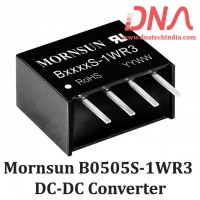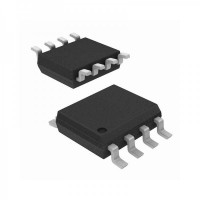The Junction Diode |
|
The effect described in the previous tutorial is achieved without any external voltage being applied to the actual PN junction resulting in the junction being in a state of equilibrium. However, if we were to make electrical connections at the ends of both the N-type and the P-type materials and then connect them to a battery source, an additional energy source now exists to overcome the barrier resulting in free charges being able to cross the depletion region from one side to the other. The behaviour of the PN junction with regards to the potential barrier width produces an asymmetrical conducting two terminal device, better known as the Junction Diode. |
|
A diode is one of the simplest semiconductor devices, which has the characteristic of passing current in one direction only. However, unlike a resistor, a diode does not behave linearly with respect to the applied voltage as the diode has an exponential I-V relationship and therefore we can not described its operation by simply using an equation such as Ohm's law. |
|
If a suitable positive voltage (forward bias) is applied between the two ends of the PN junction, it can supply free electrons and holes with the extra energy they require to cross the junction as the width of the depletion layer around the PN junction is decreased. By applying a negative voltage (reverse bias) results in the free charges being pulled away from the junction resulting in the depletion layer width being increased. This has the effect of increasing or decreasing the effective resistance of the junction itself allowing or blocking current flow through the diode. |
|
Then the depletion layer widens with an increase in the application of a reverse voltage and narrows with an increase in the application of a forward voltage. This is due to the differences in the electrical properties on the two sides of the PN junction resulting in physical changes taking place. One of the results produces rectification as seen in the PN junction diodes static I-V (current-voltage) characteristics. Rectification is shown by an asymmetrical current flow when the polarity of bias voltage is altered as shown below. |
|
|
Junction Diode Symbol and Static I-V Characteristics |
|
|
| But before we can use the PN junction as a practical device or as a rectifying device we need to firstly bias the junction, ie connect a voltage potential across it. On the voltage axis above, "Reverse Bias" refers to an external voltage potential which increases the potential barrier. An external voltage which decreases the potential barrier is said to act in the "Forward Bias" direction. |
|
There are two operating regions and three possible "biasing" conditions for the standard Junction Diode and these are:
|
|
|
Zero Biased Junction Diode |
|
When a diode is connected in a Zero Bias condition, no external potential energy is applied to the PN junction. However if the diodes terminals are shorted together, a few holes (majority carriers) in the P-type material with enough energy to overcome the potential barrier will move across the junction against this barrier potential. This is known as the "Forward Current" and is referenced as IF |
|
Likewise, holes generated in the N-type material (minority carriers), find this situation favourable and move across the junction in the opposite direction. This is known as the "Reverse Current" and is referenced as IR. This transfer of electrons and holes back and forth across the PN junction is known as diffusion, as shown below. |
|
|
Zero Biased Junction Diode |
|
|
| The potential barrier that now exists discourages the diffusion of any more majority carriers across the junction. However, the potential barrier helps minority carriers (few free electrons in the P-region and few holes in the N-region) to drift across the junction. Then an "Equilibrium" or balance will be established when the majority carriers are equal and both moving in opposite directions, so that the net result is zero current flowing in the circuit. When this occurs the junction is said to be in a state of "Dynamic Equilibrium". |
|
The minority carriers are constantly generated due to thermal energy so this state of equilibrium can be broken by raising the temperature of the PN junction causing an increase in the generation of minority carriers, thereby resulting in an increase in leakage current but an electric current cannot flow since no circuit has been connected to the PN junction. |
|
|
Reverse Biased Junction Diode |
|
When a diode is connected in a Reverse Bias condition, a positive voltage is applied to the N-type material and a negative voltage is applied to the P-type material. The positive voltage applied to the N-type material attracts electrons towards the positive electrode and away from the junction, while the holes in the P-type end are also attracted away from the junction towards the negative electrode. The net result is that the depletion layer grows wider due to a lack of electrons and holes and presents a high impedance path, almost an insulator. The result is that a high potential barrier is created thus preventing current from flowing through the semiconductor material. |
|
|
Reverse Biased Junction Diode showing an Increase in the Depletion Layer |
|
|
|
This condition represents a high resistance value to the PN junction and practically zero current flows through the junction diode with an increase in bias voltage. However, a very small leakage current does flow through the junction which can be measured in microamperes, (μA). One final point, if the reverse bias voltage Vr applied to the diode is increased to a sufficiently high enough value, it will cause the PN junction to overheat and fail due to the avalanche effect around the junction. This may cause the diode to become shorted and will result in the flow of maximum circuit current, and this shown as a step downward slope in the reverse static characteristics curve below. |
|
|
Reverse Characteristics Curve for a Junction Diode |
|
|
|
Sometimes this avalanche effect has practical applications in voltage stabilising circuits where a series limiting resistor is used with the diode to limit this reverse breakdown current to a preset maximum value thereby producing a fixed voltage output across the diode. These types of diodes are commonly known as Zener Diodes and are discussed in a later tutorial. |
|
|
Forward Biased Junction Diode |
|
When a diode is connected in a Forward Bias condition, a negative voltage is applied to the N-type material and a positive voltage is applied to the P-type material. If this external voltage becomes greater than the value of the potential barrier, approx. 0.7 volts for silicon and 0.3 volts for germanium, the potential barriers opposition will be overcome and current will start to flow. This is because the negative voltage pushes or repels electrons towards the junction giving them the energy to cross over and combine with the holes being pushed in the opposite direction towards the junction by the positive voltage. This results in a characteristics curve of zero current flowing up to this voltage point, called the "knee" on the static curves and then a high current flow through the diode with little increase in the external voltage as shown below. |
|
|
Forward Characteristics Curve for a Junction Diode |
|
|
|
The application of a forward biasing voltage on the junction diode results in the depletion layer becoming very thin and narrow which represents a low impedance path through the junction thereby allowing high currents to flow. The point at which this sudden increase in current takes place is represented on the static I-V characteristics curve above as the "knee" point. |
|
|
Forward Biased Junction Diode showing a Reduction in the Depletion Layer |
|
|
|
This condition represents the low resistance path through the PN junction allowing very large currents to flow through the diode with only a small increase in bias voltage. The actual potential difference across the junction or diode is kept constant by the action of the depletion layer at approximately 0.3v for germanium and approximately 0.7v for silicon junction diodes. Since the diode can conduct "infinite" current above this knee point as it effectively becomes a short circuit, therefore resistors are used in series with the diode to limit its current flow. Exceeding its maximum forward current specification causes the device to dissipate more power in the form of heat than it was designed for resulting in a very quick failure of the device. |
|
|
Junction Diode Summary |
|
The PN junction region of a Junction Diode has the following important characteristics: |
|
1. Semiconductors contain two types of mobile charge carriers, Holes and Electrons. |
|
2. The holes are positively charged while the electrons negatively charged. |
|
3. A semiconductor may be doped with donor impurities such as Antimony (N-type doping), so that it contains mobile charges which are primarily electrons. |
|
4. A semiconductor may be doped with acceptor impurities such as Boron (P-type doping), so that it contains mobile charges which are mainly holes. |
|
5. The junction region itself has no charge carriers and is known as the depletion region. |
|
6. The junction (depletion) region has a physical thickness that varies with the applied voltage. |
|
7. When a diode is Zero Biased no external energy source is applied and a natural Potential Barrier is developed across a depletion layer which is approximately 0.5 to 0.7v for silicon diodes and approximately 0.3 of a volt for germanium diodes. |
|
8. When a junction diode is Forward Biased the thickness of the depletion region reduces and the diode acts like a short circuit allowing full current to flow. |
|
|
In the next tutorial about diodes, we will look at the small signal diode sometimes called a switching diode that are used in general electronic circuits. A signal diode is designed for low-voltage or high frequency signal applications such as in radio or digital switching circuits as opposed to the high-current mains rectification diodes in which silicon diodes are usually used, and examine the Signal Diode static current-voltage characteristics curve and parameters. |
|
|
|
Reproduced with permission from Wayne Storr |
| http://www.electronics-tutorials.ws/diode/diode_3.html |









